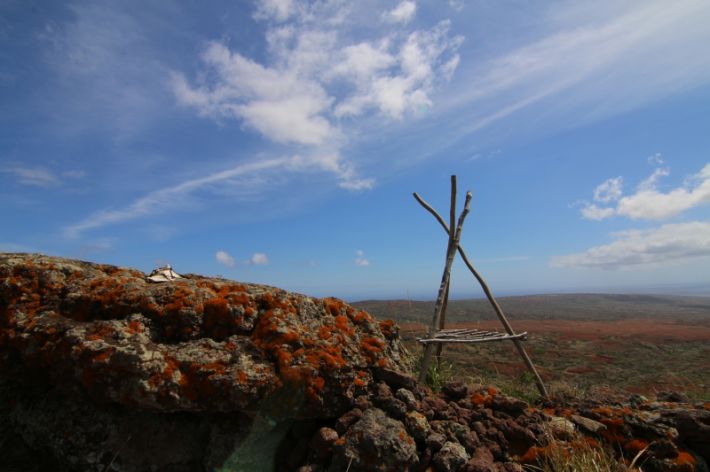As Kaho‘olawe came into view, Kali Linder relied on her na‘au – a distinct “gut” feeling – and became quiet, listening to and observing the surroundings.
The KS Kahalu‘u Preschool kumu welcomed the opportunity to absorb the mana and serenity of the quiet place, as the daily grind of work, school and kuleana at home had slowly fragmented her relationship with the environment.
Linder was one of 16 kumu and alakaʻi from across Nā Kula ʻo Kamehameha, which encompasses three campuses and 29 preschools statewide, who participated in a summer huakaʻi to Kahoʻolawe to immerse themselves in experiential ‘āina-based learning, and critically examine the role of Kahoʻolawe in Aloha ʻĀina. As educators and learners return to school this week, the experiences will be shared and recalled to help inspire haumāna in the classroom and beyond the traditional four-wall setting.
“On many of the evenings as I sat taking pictures of the Milky Way and many star lines, I reflected in the silence,” said Chris Blake, science department head at Kamehameha Schools Kapālama High School.
“Knowing that a multitude of ordinance lay over much of Kahoʻolawe, knowing that there is much work to do and understanding the importance of our work as kumu and how we will be needing to inspire our newest generation of learners and how can we share and shape their worldview to include Kaho‘olawe and ‘āina Kanaloa to strengthen their connection as kanaka leaders and kanaka scientists to bridge our past into our future. Knowing there is much work to do and I will do all that I can to help to move and progress to make these changes and to have Aloha ‘Āina be common in our thoughts and practices.”
The huakaʻi served as a key component of the E Ola Kahoʻolawe B-credit course, a professional development collaboration between Hoʻolaukoa (KS Educational Systems and Strategies) and Hoʻokahua (Cultural Vibrancy Group); it’s the first Hawaiian culture-based education B-credit course to be offered to participants across the Nā Kula system.
While on the recovering island, participants were hosted by the Kahoʻolawe Island Reserve Commission and members of the Protect Kahoʻolawe ʻOhana, who also serve as course instructors. Activities included reforestation efforts, road maintenance, dying kīhei (shawl or cape), visiting wahi pana (sacred places) and participating in culturally rich ceremonies.
At Moaʻulanui (the island’s highest peak at just over 1,400 feet), wai from across the paeʻāina was offered to call forth the Nāulu rains from Maui to refresh the island. At Kealaikahiki on Kaho‘olawe’s southwest tip, an ʻawa ceremony was held to affirm commitments to Kanaloa (an older name also used in reference to Kahoʻolawe) and Aloha ‘Āina.
“The most memorable moment was making our kīhei by using the ‘āina and kai to color and wash it,” said Ruby Redona, a librarian at Kamehameha Schools Kapālama Elementary School. “Then we dressed in our kīhei in a ceremony to dedicate ourselves to Aloha ‘Āina. We truly felt the sorrows and mana of Kanaloa. I hope to transform my lessons because of the rich, first-hand experiences I gained from this huaka’i.”
Those who participated in the E Ola Kahoʻolawe are now tasked with drawing upon their experiences and exploring ways to implement Aloha ʻĀina in their teaching, learning and leadership roles. The participants will come together throughout the fall semester as a collaborative network focused on advancing Aloha ‘Āina education and leadership. A hōʻike on December 8 will highlight proven practices that align with Aloha ʻĀina, other E Ola! Learner Outcomes, the KS Cultural Principles of Hawaiian Identity and the Hawaiian Culture-Based Education Framework for educators across Nā Kula ʻo Kamehameha.
“Kahoʻolawe and its features are a physical representation of hoʻomau, our resilience as kānaka Maoli,” said Kamehameha Schools Maui Hope Po‘o Kumu Kamuela Binkie. “While on island, we were introduced to “Tūtū Wiliwili,” an old weathered wiliwili tree whose gnarled branches have grown sideways because of the unrelenting force of the wind. Despite over 200 years of abuse, she is not only surviving, but thriving.
“For our haumāna, Tūtū Wiliwili is a symbol of hope. When a student is going through tough times, she is a reminder that we, like Tūtū Wiliwili are resilient. We will hoʻomau (persevere), we will endure, and we will thrive.”

At Moaʻulanui (the island’s highest peak at just over 1,400 feet), wai from across the paeʻāina was offered to call forth the Nāulu rains from Maui to refresh the island.

On the island, participants were introduced to “Tūtū Wiliwili,” a weathered wiliwili tree whose gnarled branches have grown sideways because of the unrelenting force of the wind. Despite over 200 years of abuse, she is not only surviving, but thriving.

During the huaka‘i, participants helped with reforestation efforts, road maintenance and removed trash.
TAGS
sp2020 goal 3,
sp2020 goal 4,
world-class hawaiian culture-based education,
world-class campusesinspiring students,
parents and teachers
CATEGORIES
Kaipuolono Article, Themes, Culture, Community, Leadership, Newsroom, Campus Programs, Community Education
Print with photos
Print text only










